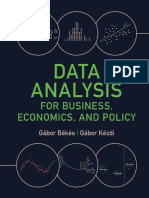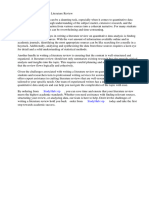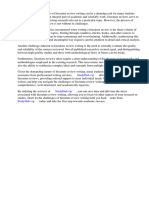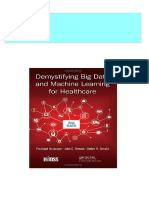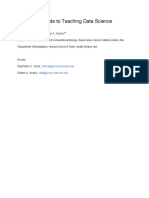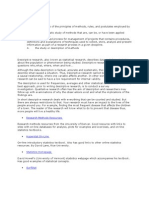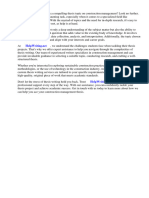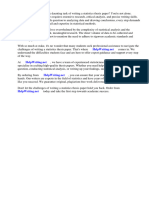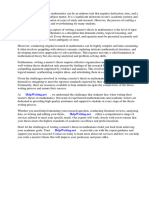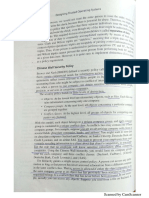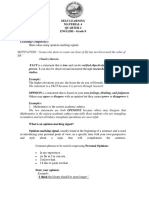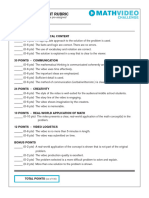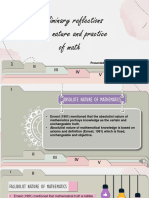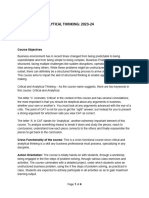Frontmatter
Frontmatter
Uploaded by
Saivarshini RavichandranCopyright:
Available Formats
Frontmatter
Frontmatter
Uploaded by
Saivarshini RavichandranOriginal Title
Copyright
Available Formats
Share this document
Did you find this document useful?
Is this content inappropriate?
Copyright:
Available Formats
Frontmatter
Frontmatter
Uploaded by
Saivarshini RavichandranCopyright:
Available Formats
Cambridge University Press
978-1-108-48301-8 — Data Analysis for Business, Economics, and Policy
Gábor Békés , Gábor Kézdi
Frontmatter
More Information
DATA ANALYSIS FOR BUSINESS, ECONOMICS, AND POLICY
This textbook provides future data analysts with the tools, methods, and skills needed to answer data-
focused, real-life questions; to carry out data analysis; and to visualize and interpret results to support
better decisions in business, economics, and public policy.
Data wrangling and exploration, regression analysis, machine learning, and causal analysis are
comprehensively covered, as well as when, why, and how the methods work, and how they relate to
each other.
As the most effective way to communicate data analysis, running case studies play a central role in
this textbook. Each case starts with an industry-relevant question and answers it by using real-world
data and applying the tools and methods covered in the textbook. Learning is then consolidated by
360 practice questions and 120 data exercises.
Extensive online resources, including raw and cleaned data and codes for all analysis in Stata, R,
and Python, can be found at http://www.gabors-data-analysis.com.
Gábor Békés is an assistant professor at the Department of Economics and Business of the Central
European University, and Director of the Business Analytics Program. He is a senior fellow at KRTK
and a research affiliate at the Center for Economic Policy Research (CEPR). He has published in top
economics journals on multinational firm activities and productivity, business clusters, and innovation
spillovers. He has managed international data collection projects on firm performance and supply
chains. He has done policy-advising (the European Commission, ECB) as well as private-sector con-
sultancy (in finance, business intelligence, and real estate). He has taught graduate-level data analysis
and economic geography courses since 2012.
Gábor Kézdi is a research associate professor at the University of Michigan’s Institute for Social
Research. He has published in top journals in economics, statistics, and political science on topics
including household finances, health, education, demography, and ethnic disadvantages and preju-
dice. He has managed several data collection projects in Europe; currently, he is co-investigator of
the Health and Retirement Study in the USA. He has consulted for various governmental and non-
governmental institutions on the disadvantage of the Roma minority and the evaluation of social
interventions. He has taught data analysis, econometrics, and labor economics from undergraduate
to PhD levels since 2002, and supervised a number of MA and PhD students.
© in this web service Cambridge University Press www.cambridge.org
Cambridge University Press
978-1-108-48301-8 — Data Analysis for Business, Economics, and Policy
Gábor Békés , Gábor Kézdi
Frontmatter
More Information
“This exciting new text covers everything today’s aspiring data scientist needs to know, managing to be comprehensive as well as
accessible. Like a good confidence interval, the Gabors have got you almost completely covered!”
Professor Joshua Angrist, Massachusetts Institute of Technology
“This is an excellent book for students learning the art of modern data analytics. It combines the latest techniques with practical
applications, replicating the implementation side of classroom teaching that is typically missing in textbooks. For example, they
used the World Management Survey data to generate exercises on firm performance for students to gain experience in handling
real data, with all its quirks, problems, and issues. For students looking to learn data analysis from one textbook, this is a great way
to proceed.”
Professor Nicholas Bloom, Department of Economics and Stanford Business School, Stanford University
“I know of few books about data analysis and visualization that are as comprehensive, deep, practical, and current as this one; and
I know of almost none that are as fun to read. Gábor Békés and Gábor Kézdi have created a most unusual and most compelling
beast: a textbook that teaches you the subject matter well and that, at the same time, you can enjoy reading cover to cover.”
Professor Alberto Cairo, University of Miami
“A beautiful integration of econometrics and data science that provides a direct path from data collection and exploratory analysis to
conventional regression modeling, then on to prediction and causal modeling. Exactly what is needed to equip the next generation
of students with the tools and insights from the two fields.”
Professor David Card, University of California–Berkeley
“This textbook is excellent at dissecting and explaining the underlying process of data analysis. Békés and Kézdi have masterfully
woven into their instruction a comprehensive range of case studies. The result is a rigorous textbook grounded in real-world
learning, at once accessible and engaging to novice scholars and advanced practitioners alike. I have every confidence it will be
valued by future generations.”
Professor Kerwin K. Charles, Yale School of Management
“This book takes you by the hand in a journey that will bring you to understand the core value of data in the fields of machine
learning and economics. The large amount of accessible examples combined with the intuitive explanation of foundational concepts
is an ideal mix for anyone who wants to do data analysis. It is highly recommended to anyone interested in the new way in which
data will be analyzed in the social sciences in the next years.”
Professor Christian Fons-Rosen, Barcelona Graduate School of Economics
“This sophisticatedly simple book is ideal for undergraduate- or Master’s-level Data Analytics courses with a broad audience. The
authors discuss the key aspects of examining data, regression analysis, prediction, Lasso, random forests, and more, using elegant
prose instead of algebra. Using well-chosen case studies, they illustrate the techniques and discuss all of them patiently and
thoroughly.”
Professor Carter Hill, Louisiana State University
“This is not an econometrics textbook. It is a data analysis textbook. And a highly unusual one - written in plain English, based on
simplified notation, and full of case studies. An excellent starting point for future data analysts or anyone interested in finding out
what data can tell us.”
Professor Beata Javorcik, University of Oxford
“A multifaceted book that considers many sides of data analysis, all of them important for the contemporary student and practi-
tioner. It brings together classical statistics, regression, and causal inference, sending the message that awareness of all three aspects
is important for success in this field. Many ’best practices’ are discussed in accessible language, and illustrated using interesting
datasets.”
Professor llya Ryzhov, University of Maryland
“This is a fantastic book to have. Strong data skills are critical for modern business and economic research, and this text provides
a thorough and practical guide to acquiring them. Highly recommended.”
Professor John van Reenen, MIT Sloan
“Energy and climate change is a major public policy challenge, where high-quality data analysis is the foundation of solid policy.
This textbook will make an important contribution to this with its innovative approach. In addition to the comprehensive treatment
of modern econometric techniques, the book also covers the less glamorous but crucial aspects of procuring and cleaning data,
and drawing useful inferences from less-than-perfect datasets. An important and practical combination for both academic and
policy professionals.”
Laszlo Varro, Chief Economist, International Energy Agency
© in this web service Cambridge University Press www.cambridge.org
Cambridge University Press
978-1-108-48301-8 — Data Analysis for Business, Economics, and Policy
Gábor Békés , Gábor Kézdi
Frontmatter
More Information
DATA ANALYSIS
FOR BUSINESS,
ECONOMICS,
AND POLICY
Gábor Békés
Central European University, Vienna and Budapest
Gábor Kézdi
University of Michigan, Ann Arbor
© in this web service Cambridge University Press www.cambridge.org
Cambridge University Press
978-1-108-48301-8 — Data Analysis for Business, Economics, and Policy
Gábor Békés , Gábor Kézdi
Frontmatter
More Information
University Printing House, Cambridge CB2 8BS, United Kingdom
One Liberty Plaza, 20th Floor, New York, NY 10006, USA
477 Williamstown Road, Port Melbourne, VIC 3207, Australia
314-321, 3rd Floor, Plot 3, Splendor Forum, Jasola District Centre, New Delhi - 110025, India
103 Penang Road, #05-06/07, Visioncrest Commercial, Singapore 238467
Cambridge University Press is part of the University of Cambridge.
It furthers the University’s mission by disseminating knowledge in the pursuit of
education, learning and research at the highest international levels of excellence.
www.cambridge.org
Information on this title: www.cambridge.org/9781108483018
DOI: 10.1017/9781108591102
© Gábor Békés and Gábor Kézdi 2021
This publication is in copyright. Subject to statutory exception
and to the provisions of relevant collective licensing agreements,
no reproduction of any part may take place without the written
permission of Cambridge University Press.
First published 2021
A catalogue record for this publication is available from the British Library
ISBN 978-1-108-48301-8 Hardback
ISBN 978-1-108-71620-8 Paperback
Additional resources for this publication at www.cambridge.org/bekeskezdi and www.gabors-data-analysis.com
Cambridge University Press has no responsibility for the persistence or
accuracy of URLs for external or third-party internet websites referred to in
this publication, and does not guarantee that any content on such websites is,
or will remain, accurate or appropriate.
© in this web service Cambridge University Press www.cambridge.org
Cambridge University Press
978-1-108-48301-8 — Data Analysis for Business, Economics, and Policy
Gábor Békés , Gábor Kézdi
Frontmatter
More Information
BRIEF CONTENTS
Why Use This Book page xxi
Simplified Notation xxiv
Acknowledgments xxv
I DATA EXPLORATION 1
1 Origins of Data 3
2 Preparing Data for Analysis 30
3 Exploratory Data Analysis 58
4 Comparison and Correlation 96
5 Generalizing from Data 118
6 Testing Hypotheses 143
II REGRESSION ANALYSIS 169
7 Simple Regression 171
8 Complicated Patterns and Messy Data 200
9 Generalizing Results of a Regression 236
10 Multiple Linear Regression 266
11 Modeling Probabilities 297
12 Regression with Time Series Data 329
III PREDICTION 363
13 A Framework for Prediction 365
14 Model Building for Prediction 391
15 Regression Trees 417
16 Random Forest and Boosting 438
© in this web service Cambridge University Press www.cambridge.org
Cambridge University Press
978-1-108-48301-8 — Data Analysis for Business, Economics, and Policy
Gábor Békés , Gábor Kézdi
Frontmatter
More Information
vi Brief Contents
17 Probability Prediction and Classification 457
18 Forecasting from Time Series Data 487
IV CAUSAL ANALYSIS 517
19 A Framework for Causal Analysis 519
20 Designing and Analyzing Experiments 555
21 Regression and Matching with Observational Data 588
22 Difference-in-Differences 620
23 Methods for Panel Data 649
24 Appropriate Control Groups for Panel Data 681
References 704
Index 709
© in this web service Cambridge University Press www.cambridge.org
Cambridge University Press
978-1-108-48301-8 — Data Analysis for Business, Economics, and Policy
Gábor Békés , Gábor Kézdi
Frontmatter
More Information
CONTENTS
Why Use This Book page xxi
Simplified Notation xxiv
Acknowledgments xxv
I DATA EXPLORATION 1
1 Origins of Data 3
1.1 What Is Data? 4
1.2 Data Structures 5
1.A1 CASE STUDY – Finding a Good Deal among Hotels: Data Collection 6
1.3 Data Quality 7
1.B1 CASE STUDY – Comparing Online and Offline Prices: Data Collection 9
1.C1 CASE STUDY – Management Quality and Firm Performance: Data Collection 10
1.4 How Data Is Born: The Big Picture 11
1.5 Collecting Data from Existing Sources 12
1.A2 CASE STUDY – Finding a Good Deal among Hotels: Data Collection 14
1.B2 CASE STUDY – Comparing Online and Offline Prices: Data Collection 15
1.6 Surveys 16
1.C2 CASE STUDY – Management Quality and Firm Size: Data Collection 18
1.7 Sampling 18
1.8 Random Sampling 19
1.B3 CASE STUDY – Comparing Online and Offline Prices: Data Collection 21
1.C3 CASE STUDY – Management Quality and Firm Size: Data Collection 21
1.9 Big Data 22
1.10 Good Practices in Data Collection 24
1.11 Ethical and Legal Issues of Data Collection 26
1.12 Main Takeaways 27
Practice Questions 27
Data Exercises 28
References and Further Reading 28
2 Preparing Data for Analysis 30
2.1 Types of Variables 31
2.2 Stock Variables, Flow Variables 33
2.3 Types of Observations 33
2.4 Tidy Data 35
2.A1 CASE STUDY – Finding a Good Deal among Hotels: Data Preparation 36
2.5 Tidy Approach for Multi-dimensional Data 37
2.B1 CASE STUDY – Displaying Immunization Rates across Countries 37
2.6 Relational Data and Linking Data Tables 38
© in this web service Cambridge University Press www.cambridge.org
Cambridge University Press
978-1-108-48301-8 — Data Analysis for Business, Economics, and Policy
Gábor Békés , Gábor Kézdi
Frontmatter
More Information
viii Contents
2.C1 CASE STUDY – Identifying Successful Football Managers 40
2.7 Entity Resolution: Duplicates, Ambiguous Identification, and Non-entity
Rows 42
2.C2 CASE STUDY – Identifying Successful Football Managers 43
2.8 Discovering Missing Values 44
2.9 Managing Missing Values 46
2.A2 CASE STUDY – Finding a Good Deal among Hotels: Data Preparation 47
2.10 The Process of Cleaning Data 48
2.11 Reproducible Workflow: Write Code and Document Your Steps 49
2.12 Organizing Data Tables for a Project 50
2.C3 CASE STUDY – Identifying Successful Football Managers 52
2.C4 CASE STUDY – Identifying Successful Football Managers 53
2.13 Main Takeaways 54
Practice Questions 54
Data Exercises 55
References and Further Reading 56
2.U1 Under the Hood: Naming Files 56
3Exploratory Data Analysis 58
3.1Why Do Exploratory Data Analysis? 59
3.2Frequencies and Probabilities 60
3.3Visualizing Distributions 61
3.A1 CASE STUDY – Finding a Good Deal among Hotels: Data Exploration 62
3.4Extreme Values 65
3.A2 CASE STUDY – Finding a Good Deal among Hotels: Data Exploration 66
3.5Good Graphs: Guidelines for Data Visualization 68
3.A3 CASE STUDY – Finding a Good Deal among Hotels: Data Exploration 71
3.6Summary Statistics for Quantitative Variables 72
3.B1 CASE STUDY – Comparing Hotel Prices in Europe: Vienna vs. London 74
3.7Visualizing Summary Statistics 77
3.C1 CASE STUDY – Measuring Home Team Advantage in Football 78
3.8Good Tables 80
3.C2 CASE STUDY – Measuring Home Team Advantage in Football 82
3.9Theoretical Distributions 83
3.D1 CASE STUDY – Distributions of Body Height and Income 85
3.10 Steps of Exploratory Data Analysis 87
3.11 Main Takeaways 88
Practice Questions 88
Data Exercises 89
References and Further Reading 90
3.U1 Under the Hood: More on Theoretical Distributions 90
Bernoulli Distribution 91
Binomial Distribution 91
Uniform Distribution 92
Power-Law Distribution 92
© in this web service Cambridge University Press www.cambridge.org
Cambridge University Press
978-1-108-48301-8 — Data Analysis for Business, Economics, and Policy
Gábor Békés , Gábor Kézdi
Frontmatter
More Information
Contents ix
4 Comparison and Correlation 96
4.1 The y and the x 97
4.A1 CASE STUDY – Management Quality and Firm Size: Describing Patterns of
Association 98
4.2 Conditioning 100
4.3 Conditional Probabilities 101
4.A2 CASE STUDY – Management Quality and Firm Size: Describing Patterns of
Association 102
4.4 Conditional Distribution, Conditional Expectation 103
4.5 Conditional Distribution, Conditional Expectation with Quantitative x 104
4.A3 CASE STUDY – Management Quality and Firm Size: Describing Patterns of
Association 105
4.6 Dependence, Covariance, Correlation 108
4.7 From Latent Variables to Observed Variables 110
4.A4 CASE STUDY – Management Quality and Firm Size: Describing Patterns of
Association 111
4.8 Sources of Variation in x 113
4.9 Main Takeaways 114
Practice Questions 115
Data Exercises 115
References and Further Reading 116
4.U1 Under the Hood: Inverse Conditional Probabilities, Bayes’ Rule 116
5Generalizing from Data 118
5.1When to Generalize and to What? 119
5.A1 CASE STUDY – What Likelihood of Loss to Expect on a Stock Portfolio
? 121
5.2Repeated Samples, Sampling Distribution, Standard Error 122
5.A2 CASE STUDY – What Likelihood of Loss to Expect on a Stock Portfolio
? 123
5.3Properties of the Sampling Distribution 125
5.A3 CASE STUDY – What Likelihood of Loss to Expect on a Stock Portfolio
? 127
5.4The confidence interval 128
5.A4 CASE STUDY – What Likelihood of Loss to Expect on a Stock Portfolio
? 129
5.5Discussion of the CI: Confidence or Probability? 129
5.6Estimating the Standard Error with the Bootstrap Method 130
5.A5 CASE STUDY – What Likelihood of Loss to Expect on a Stock Portfolio
? 132
5.7The Standard Error Formula 133
5.A6 CASE STUDY – What Likelihood of Loss to Expect on a Stock Portfolio
? 134
5.8External Validity 135
5.A7 CASE STUDY – What Likelihood of Loss to Expect on a Stock Portfolio
? 136
5.9Big Data, Statistical Inference, External Validity 137
5.10 Main Takeaways 138
Practice Questions 138
Data Exercises 139
References and Further Reading 139
5.U1 Under the Hood: The Law of Large Numbers and the Central Limit Theorem 140
© in this web service Cambridge University Press www.cambridge.org
Cambridge University Press
978-1-108-48301-8 — Data Analysis for Business, Economics, and Policy
Gábor Békés , Gábor Kézdi
Frontmatter
More Information
x Contents
6 Testing Hypotheses 143
6.1 The Logic of Testing Hypotheses 144
6.A1 CASE STUDY – Comparing Online and Offline Prices: Testing the Difference 145
6.2 Null Hypothesis, Alternative Hypothesis 148
6.3 The t-Test 149
6.4 Making a Decision; False Negatives, False Positives 150
6.5 The p-Value 154
6.A2 CASE STUDY – Comparing Online and Offline Prices: Testing the Difference 155
6.6 Steps of Hypothesis Testing 157
6.7 One-Sided Alternatives 158
6.B1 CASE STUDY – Testing the Likelihood of Loss on a Stock Portfolio 159
6.8 Testing Multiple Hypotheses 160
6.A3 CASE STUDY – Comparing Online and Offline Prices: Testing the Difference 161
6.9 p-Hacking 162
6.10 Testing Hypotheses with Big Data 164
6.11 Main Takeaways 165
Practice Questions 165
Data Exercises 166
References and Further Reading 167
II REGRESSION ANALYSIS 169
7 Simple Regression 171
7.1 When and Why Do Simple Regression Analysis? 172
7.2 Regression: Definition 172
7.3 Non-parametric Regression 174
7.A1 CASE STUDY – Finding a Good Deal among Hotels with Simple
Regression 175
7.4 Linear Regression: Introduction 178
7.5 Linear Regression: Coefficient Interpretation 179
7.6 Linear Regression with a Binary Explanatory Variable 180
7.7 Coefficient Formula 181
7.A2 CASE STUDY – Finding a Good Deal among Hotels with Simple Regression 183
7.8 Predicted Dependent Variable and Regression Residual 184
7.A3 CASE STUDY – Finding a Good Deal among Hotels with Simple Regression 185
7.9 Goodness of Fit, R-Squared 188
7.10 Correlation and Linear Regression 189
7.11 Regression Analysis, Regression toward the Mean, Mean Reversion 190
7.12 Regression and Causation 190
7.A4 CASE STUDY – Finding a Good Deal among Hotels with Simple
Regression 192
7.13 Main Takeaways 192
Practice Questions 193
Data Exercises 193
References and Further Reading 194
© in this web service Cambridge University Press www.cambridge.org
Cambridge University Press
978-1-108-48301-8 — Data Analysis for Business, Economics, and Policy
Gábor Békés , Gábor Kézdi
Frontmatter
More Information
Contents xi
7.U1 Under the Hood: Derivation of the OLS Formulae for the Intercept and
Slope Coefficients 194
7.U2 Under the Hood: More on Residuals and Predicted Values with OLS 197
8 Complicated Patterns and Messy Data 200
8.1 When and Why Care about the Shape of the Association between y and
?x 201
8.2 Taking Relative Differences or Log 202
8.3 Log Transformation and Non-positive Values 204
8.4 Interpreting Log Values in a Regression 206
8.A1 CASE STUDY – Finding a Good Deal among Hotels with Nonlinear Function 207
8.5 Other Transformations of Variables 210
8.B1 CASE STUDY – How is Life Expectancy Related to the Average Income of a
Country? 210
8.6 Regression with a Piecewise Linear Spline 215
8.7 Regression with Polynomial 216
8.8 Choosing a Functional Form in a Regression 218
8.B2 CASE STUDY – How is Life Expectancy Related to the Average Income of a
Country? 219
8.9 Extreme Values and Influential Observations 221
8.10 Measurement Error in Variables 222
8.11 Classical Measurement Error 223
8.C1 CASE STUDY – Hotel Ratings and Measurement Error 225
8.12 Non-classical Measurement Error and General Advice 227
8.13 Using Weights in Regression Analysis 228
8.B3 CASE STUDY – How is Life Expectancy Related to the Average Income of a
Country? 229
8.14 Main Takeaways 230
Practice Questions 231
Data Exercises 232
References and Further Reading 232
8.U1 Under the Hood: Details of the Log Approximation 233
8.U2 Under the Hood: Deriving the Consequences of Classical Measurement
Error 234
9 Generalizing Results of a Regression 236
9.1 Generalizing Linear Regression Coefficients 237
9.2 Statistical Inference: CI and SE of Regression Coefficients 238
9.A1 CASE STUDY – Estimating Gender and Age Differences in Earnings 240
9.3 Intervals for Predicted Values 243
9.A2 CASE STUDY – Estimating Gender and Age Differences in Earnings 245
9.4 Testing Hypotheses about Regression Coefficients 249
9.5 Testing More Complex Hypotheses 251
9.A3 CASE STUDY – Estimating Gender and Age Differences in Earnings 252
9.6 Presenting Regression Results 253
9.A4 CASE STUDY – Estimating Gender and Age Differences in Earnings 254
9.7 Data Analysis to Help Assess External Validity 256
© in this web service Cambridge University Press www.cambridge.org
Cambridge University Press
978-1-108-48301-8 — Data Analysis for Business, Economics, and Policy
Gábor Békés , Gábor Kézdi
Frontmatter
More Information
xii Contents
9.B1 CASE STUDY – How Stable is the Hotel Price–Distance to Center
Relationship? 256
9.8 Main Takeaways 260
Practice Questions 261
Data Exercises 261
References and Further Reading 262
9.U1 Under the Hood: The Simple SE Formula for Regression Intercept 262
9.U2 Under the Hood: The Law of Large Numbers for β̂ 263
9.U3 Under the Hood: Deriving SE(β̂ ) with the Central Limit Theorem 264
9.U4 Under the Hood: Degrees of Freedom Adjustment for the SE Formula 265
10 Multiple Linear Regression 266
10.1 Multiple Regression: Why and When? 267
10.2 Multiple Linear Regression with Two Explanatory Variables 267
10.3 Multiple Regression and Simple Regression: Omitted Variable Bias 268
10.A1 CASE STUDY – Understanding the Gender Difference in Earnings 270
10.4 Multiple Linear Regression Terminology 272
10.5 Standard Errors and Confidence Intervals in Multiple Linear Regression 273
10.6 Hypothesis Testing in Multiple Linear Regression 275
10.A2 CASE STUDY – Understanding the Gender Difference in Earnings 275
10.7 Multiple Linear Regression with Three or More Explanatory Variables 276
10.8 Nonlinear Patterns and Multiple Linear Regression 277
10.A3 CASE STUDY – Understanding the Gender Difference in Earnings 278
10.9 Qualitative Right-Hand-Side Variables 279
10.A4 CASE STUDY – Understanding the Gender Difference in Earnings 280
10.10 Interactions: Uncovering Different Slopes across Groups 282
10.A5 CASE STUDY – Understanding the Gender Difference in Earnings 284
10.11 Multiple Regression and Causal Analysis 286
10.A6 CASE STUDY – Understanding the Gender Difference in Earnings 287
10.12 Multiple Regression and Prediction 290
10.B1 CASE STUDY – Finding a Good Deal among Hotels with Multiple Regression 292
10.13 Main Takeaways 294
Practice Questions 294
Data Exercises 295
References and Further Reading 296
10.U1 Under the Hood: A Two-Step Procedure to Get the Multiple Regression
Coefficient 296
11 Modeling Probabilities 297
11.1 The Linear Probability Model 298
11.2 Predicted Probabilities in the Linear Probability Model 299
11.A1 CASE STUDY – Does Smoking Pose a Health Risk? 301
11.3 Logit and Probit 307
11.A2 CASE STUDY – Does Smoking Pose a Health Risk? 308
11.4 Marginal Differences 309
11.A3 CASE STUDY – Does Smoking Pose a Health Risk? 311
© in this web service Cambridge University Press www.cambridge.org
Cambridge University Press
978-1-108-48301-8 — Data Analysis for Business, Economics, and Policy
Gábor Békés , Gábor Kézdi
Frontmatter
More Information
Contents xiii
11.5 Goodness of Fit: R-Squared and Alternatives 312
11.6 The Distribution of Predicted Probabilities 314
11.7 Bias and Calibration 314
11.B1 CASE STUDY – Are Australian Weather Forecasts Well Calibrated? 315
11.8 Refinement 317
11.A4 CASE STUDY – Does Smoking Pose a Health risk? 318
11.9 Using Probability Models for Other Kinds of y Variables 321
11.10 Main Takeaways 323
Practice Questions 323
Data Exercises 324
References and Further Reading 325
11.U1 Under the Hood: Saturated Models 325
11.U2 Under the Hood: Maximum Likelihood Estimation and Search Algorithms 326
11.U3 Under the Hood: From Logit and Probit Coefficients to Marginal Differences 327
12 Regression with Time Series Data 329
12.1 Preparation of Time Series Data 330
12.2 Trend and Seasonality 332
12.3 Stationarity, Non-stationarity, Random Walk 333
12.A1 CASE STUDY – Returns on a Company Stock and Market Returns 335
12.4 Time Series Regression 338
12.A2 CASE STUDY – Returns on a Company Stock and Market Returns 339
12.5 Trends, Seasonality, Random Walks in a Regression 343
12.B1 CASE STUDY – Electricity Consumption and Temperature 346
12.6 Serial Correlation 349
12.7 Dealing with Serial Correlation in Time Series Regressions 350
12.B2 CASE STUDY – Electricity Consumption and Temperature 352
12.8 Lags of x in a Time Series Regression 355
12.B3 CASE STUDY – Electricity Consumption and Temperature 357
12.9 The Process of Time Series Regression Analysis 359
12.10 Main Takeaways 360
Practice Questions 360
Data Exercises 361
References and Further Reading 362
12.U1 Under the Hood: Testing for Unit Root 362
III PREDICTION 363
13 A Framework for Prediction 365
13.1 Prediction Basics 366
13.2 Various Kinds of Prediction 367
13.A1 CASE STUDY – Predicting Used Car Value with Linear Regressions 369
13.3 The Prediction Error and Its Components 369
13.A2 CASE STUDY – Predicting Used Car Value with Linear Regressions 371
13.4 The Loss Function 373
© in this web service Cambridge University Press www.cambridge.org
Cambridge University Press
978-1-108-48301-8 — Data Analysis for Business, Economics, and Policy
Gábor Békés , Gábor Kézdi
Frontmatter
More Information
xiv Contents
13.5 Mean Squared Error (MSE) and Root Mean Squared Error (RMSE) 375
13.6 Bias and Variance of Predictions 376
13.7 The Task of Finding the Best Model 377
13.8 Finding the Best Model by Best Fit and Penalty: The BIC 379
13.9 Finding the Best Model by Training and Test Samples 380
13.10 Finding the Best Model by Cross-Validation 382
13.A3 CASE STUDY – Predicting Used Car Value with Linear Regressions 383
13.11 External Validity and Stable Patterns 384
13.A4 CASE STUDY – Predicting Used Car Value with Linear Regressions 386
13.12 Machine Learning and the Role of Algorithms 387
13.13 Main Takeaways 389
Practice Questions 389
Data Exercises 390
References and Further Reading 390
14 Model Building for Prediction 391
14.1 Steps of Prediction 392
14.2 Sample Design 393
14.3 Label Engineering and Predicting Log y 394
14.A1 CASE STUDY – Predicting Used Car Value: Log Prices 395
14.4 Feature Engineering: Dealing with Missing Values 397
14.5 Feature Engineering: What x Variables to Have and in What Functional
Form 398
14.B1 CASE STUDY – Predicting Airbnb Apartment Prices: Selecting a Regression
Model 399
14.6 We Can’t Try Out All Possible Models 402
14.7 Evaluating the Prediction Using a Holdout Set 403
14.B2 CASE STUDY – Predicting Airbnb Apartment Prices: Selecting a Regression
Model 404
14.8 Selecting Variables in Regressions by LASSO 407
14.B3 CASE STUDY – Predicting Airbnb Apartment Prices: Selecting a Regression
Model 409
14.9 Diagnostics 410
14.B4 CASE STUDY – Predicting Airbnb Apartment Prices: Selecting a Regression
Model 411
14.10 Prediction with Big Data 412
14.11 Main Takeaways 414
Practice Questions 414
Data Exercises 415
References and Further Reading 415
14.U1 Under the Hood: Text Parsing 415
14.U2 Under the Hood: Log Correction 416
15 Regression Trees 417
15.1 The Case for Regression Trees 418
15.2 Regression Tree Basics 419
© in this web service Cambridge University Press www.cambridge.org
Cambridge University Press
978-1-108-48301-8 — Data Analysis for Business, Economics, and Policy
Gábor Békés , Gábor Kézdi
Frontmatter
More Information
Contents xv
15.3 Measuring Fit and Stopping Rules 420
15.A1 CASE STUDY – Predicting Used Car Value with a Regression Tree 421
15.4 Regression Tree with Multiple Predictor Variables 425
15.5 Pruning a Regression Tree 426
15.6 A Regression Tree is a Non-parametric Regression 426
15.A2 CASE STUDY – Predicting Used Car Value with a Regression Tree 427
15.7 Variable Importance 430
15.8 Pros and Cons of Using a Regression Tree for Prediction 431
15.A3 CASE STUDY – Predicting Used Car Value with a Regression Tree 433
15.9 Main Takeaways 435
Practice Questions 435
Data Exercises 436
References and Further Reading 437
16 Random Forest and Boosting 438
16.1 From a Tree to a Forest: Ensemble Methods 439
16.2 Random Forest 440
16.3 The Practice of Prediction with Random Forest 442
16.A1 CASE STUDY – Predicting Airbnb Apartment Prices with Random Forest 443
16.4 Diagnostics: The Variable Importance Plot 444
16.5 Diagnostics: The Partial Dependence Plot 445
16.6 Diagnostics: Fit in Various Subsets 446
16.A2 CASE STUDY – Predicting Airbnb Apartment Prices with Random Forest 446
16.7 An Introduction to Boosting and the GBM Model 449
16.A3 CASE STUDY – Predicting Airbnb Apartment Prices with Random Forest 450
16.8 A Review of Different Approaches to Predict a Quantitative y 452
16.9 Main Takeaways 454
Practice Questions 454
Data Exercises 455
References and Further Reading 456
17 Probability Prediction and Classification 457
17.1 Predicting a Binary y: Probability Prediction and Classification 458
17.A1 CASE STUDY – Predicting Firm Exit: Probability and Classification 459
17.2 The Practice of Predicting Probabilities 462
17.A2 CASE STUDY – Predicting Firm Exit: Probability and Classification 463
17.3 Classification and the Confusion Table 466
17.4 Illustrating the Trade-Off between Different Classification Thresholds: The
ROC Curve 468
17.A3 CASE STUDY – Predicting Firm Exit: Probability and Classification 469
17.5 Loss Function and Finding the Optimal Classification Threshold 471
17.A4 CASE STUDY – Predicting Firm Exit: Probability and Classification 473
17.6 Probability Prediction and Classification with Random Forest 475
17.A5 CASE STUDY – Predicting Firm Exit: Probability and Classification 477
17.7 Class Imbalance 480
17.8 The Process of Prediction with a Binary Target Variable 481
© in this web service Cambridge University Press www.cambridge.org
Cambridge University Press
978-1-108-48301-8 — Data Analysis for Business, Economics, and Policy
Gábor Békés , Gábor Kézdi
Frontmatter
More Information
xvi Contents
17.9 Main Takeaways 482
Practice Questions 482
Data Exercises 483
References and Further Reading 484
17.U1 Under the Hood: The Gini Node Impurity Measure and MSE 484
17.U2 Under the Hood: On the Method of Finding an Optimal Threshold 485
18 Forecasting from Time Series Data 487
18.1 Forecasting: Prediction Using Time Series Data 488
18.2 Holdout, Training, and Test Samples in Time Series Data 489
18.3 Long-Horizon Forecasting: Seasonality and Predictable Events 491
18.4 Long-Horizon Forecasting: Trends 492
18.A1 CASE STUDY – Forecasting Daily Ticket Volumes for a Swimming Pool 494
18.5 Forecasting for a Short Horizon Using the Patterns of Serial Correlation 500
18.6 Modeling Serial Correlation: AR(1) 500
18.7 Modeling Serial Correlation: ARIMA 501
18.B1 CASE STUDY – Forecasting a Home Price Index 503
18.8 VAR: Vector Autoregressions 505
18.B2 CASE STUDY – Forecasting a Home Price Index 507
18.9 External Validity of Forecasts 509
18.B3 CASE STUDY – Forecasting a Home Price Index 510
18.10 Main Takeaways 512
Practice Questions 512
Data Exercises 513
References and Further Reading 514
18.U1 Under the Hood: Details of the ARIMA Model 514
18.U2 Under the Hood: Auto-Arima 516
IV CAUSAL ANALYSIS 517
19 A Framework for Causal Analysis 519
19.1 Intervention, Treatment, Subjects, Outcomes 520
19.2 Potential Outcomes 522
19.3 The Individual Treatment Effect 523
19.4 Heterogeneous Treatment Effects 524
19.5 ATE: The Average Treatment Effect 525
19.6 Average Effects in Subgroups and ATET 527
19.7 Quantitative Causal Variables 527
19.A1 CASE STUDY – Food and Health 528
19.8 Ceteris Paribus: Other Things Being the Same 530
19.9 Causal Maps 531
19.10 Comparing Different Observations to Uncover Average Effects 533
19.11 Random Assignment 535
19.12 Sources of Variation in the Causal Variable 536
19.A2 CASE STUDY – Food and Health 537
© in this web service Cambridge University Press www.cambridge.org
Cambridge University Press
978-1-108-48301-8 — Data Analysis for Business, Economics, and Policy
Gábor Békés , Gábor Kézdi
Frontmatter
More Information
Contents xvii
19.13 Experimenting versus Conditioning 539
19.14 Confounders in Observational Data 541
19.15 From Latent Variables to Measured Variables 543
19.16 Bad Conditioners: Variables Not to Condition On 544
19.A3 CASE STUDY – Food and Health 545
19.17 External Validity, Internal Validity 549
19.18 Constructive Skepticism 551
19.19 Main Takeaways 552
Practice Questions 552
Data Exercises 553
References and Further Reading 554
20 Designing and Analyzing Experiments 555
20.1 Randomized Experiments and Potential Outcomes 556
20.2 Field Experiments, A/B Testing, Survey Experiments 557
20.A1 CASE STUDY – Working from Home and Employee
Performance 558
20.B1 CASE STUDY – Fine Tuning Social Media Advertising 559
20.3 The Experimental Setup: Definitions 560
20.4 Random Assignment in Practice 560
20.5 Number of Subjects and Proportion Treated 562
20.6 Random Assignment and Covariate Balance 563
20.A2 CASE STUDY – Working from Home and Employee Performance 565
20.7 Imperfect Compliance and Intent-to-Treat 567
20.A3 CASE STUDY – Working from Home and Employee Performance 569
20.8 Estimation and Statistical Inference 570
20.B2 CASE STUDY – Fine Tuning Social Media Advertising 571
20.9 Including Covariates in a Regression 572
20.A4 CASE STUDY – Working from Home and Employee Performance 573
20.10 Spillovers 576
20.11 Additional Threats to Internal Validity 577
20.A5 CASE STUDY – Working from Home and Employee Performance 579
20.12 External Validity, and How to Use the Results in Decision Making 581
20.A6 CASE STUDY – Working from Home and Employee Performance 582
20.13 Main Takeaways 583
Practice Questions 584
Data Exercises 585
References and Further Reading 585
20.U1 Under the Hood: LATE: The Local Average Treatment Effect 586
20.U2 Under the Hood: The Formula for Sample Size Calculation 586
21 Regression and Matching with Observational Data 588
21.1 Thought Experiments 589
21.A1 CASE STUDY – Founder/Family Ownership and Quality of Management 590
21.2 Variables to Condition on, Variables Not to Condition On 591
21.A2 CASE STUDY – Founder/Family Ownership and Quality of Management 592
© in this web service Cambridge University Press www.cambridge.org
Cambridge University Press
978-1-108-48301-8 — Data Analysis for Business, Economics, and Policy
Gábor Békés , Gábor Kézdi
Frontmatter
More Information
xviii Contents
21.3 Conditioning on Confounders by Regression 595
21.4 Selection of Variables and Functional Form in a Regression for Causal
Analysis 597
21.A3 CASE STUDY – Founder/Family Ownership and Quality of Management 598
21.5 Matching 601
21.6 Common Support 603
21.7 Matching on the Propensity Score 604
21.A4 CASE STUDY – Founder/Family Ownership and Quality of Management 605
21.8 Comparing Linear Regression and Matching 607
21.A5 CASE STUDY – Founder/Family Ownership and Quality of Management 609
21.9 Instrumental Variables 610
21.10 Regression-Discontinuity 613
21.11 Main Takeaways 614
Practice Questions 614
Data Exercises 615
References and Further Reading 616
21.U1 Under the Hood: Unobserved Heterogeneity and Endogenous x in a
Regression 616
21.U2 Under the hood: LATE is IV 618
22 Difference-in-Differences 620
22.1 Conditioning on Pre-intervention Outcomes 621
22.2 Basic Difference-in-Differences Analysis: Comparing Average Changes 622
22.A1 CASE STUDY – How Does a Merger between Airlines Affect Prices? 625
22.3 The Parallel Trends Assumption 629
22.A2 CASE STUDY – How Does a Merger between Airlines Affect Prices? 631
22.4 Conditioning on Additional Confounders in Diff-in-Diffs Regressions 633
22.A3 CASE STUDY – How Does a Merger between Airlines Affect Prices? 635
22.5 Quantitative Causal Variable 637
22.A4 CASE STUDY – How Does a Merger between Airlines Affect Prices? 638
22.6 Difference-in-Differences with Pooled Cross-Sections 640
22.A5 CASE STUDY – How Does a Merger between Airlines Affect Prices? 643
22.7 Main Takeaways 645
Practice Questions 646
Data Exercises 647
References and Further Reading 648
23 Methods for Panel Data 649
23.1 Multiple Time Periods Can Be Helpful 650
23.2 Estimating Effects Using Observational Time Series 651
23.3 Lags to Estimate the Time Path of Effects 653
23.4 Leads to Examine Pre-trends and Reverse Effects 653
23.5 Pooled Time Series to Estimate the Effect for One Unit 654
23.A1 CASE STUDY – Import Demand and Industrial Production 656
23.6 Panel Regression with Fixed Effects 659
23.7 Aggregate Trend 661
© in this web service Cambridge University Press www.cambridge.org
Cambridge University Press
978-1-108-48301-8 — Data Analysis for Business, Economics, and Policy
Gábor Békés , Gábor Kézdi
Frontmatter
More Information
Contents xix
23.B1 CASE STUDY – Immunization against Measles and Saving Children 662
23.8 Clustered Standard Errors 665
23.9 Panel Regression in First Differences 666
23.10 Lags and Leads in FD Panel Regressions 667
23.B2 CASE STUDY – Immunization against Measles and Saving Children 669
23.11 Aggregate Trend and Individual Trends in FD Models 671
23.B3 CASE STUDY – Immunization against Measles and Saving Children 672
23.12 Panel Regressions and Causality 674
23.13 First Differences or Fixed Effects? 675
23.14 Dealing with Unbalanced Panels 677
23.15 Main Takeaways 678
Practice Questions 678
Data Exercises 680
References and Further Reading 680
24 Appropriate Control Groups for Panel Data 681
24.1 When and Why to Select a Control Group in xt Panel Data 682
24.2 Comparative Case Studies 682
24.3 The Synthetic Control Method 683
24.A1 CASE STUDY – Estimating the Effect of the 2010 Haiti Earthquake on GDP 684
24.4 Event Studies 687
24.B1 CASE STUDY – Estimating the Impact of Replacing Football Team Managers 690
24.5 Selecting a Control Group in Event Studies 694
24.B2 CASE STUDY – Estimating the Impact of Replacing Football Team Managers 696
24.6 Main Takeaways 701
Practice Questions 701
Data Exercises 702
References and Further Reading 703
References 704
Index 709
© in this web service Cambridge University Press www.cambridge.org
Cambridge University Press
978-1-108-48301-8 — Data Analysis for Business, Economics, and Policy
Gábor Békés , Gábor Kézdi
Frontmatter
More Information
WHY USE THIS BOOK
An applied data analysis textbook for future professionals
Data analysis is a process. It starts with formulating a question and collecting appropriate data,
or assessing whether the available data can help answer the question. Then comes cleaning and
organizing the data, tedious but essential tasks that affect the results of the analysis as much as any
other step in the process. Exploratory data analysis gives context to the eventual results and helps
deciding the details of the analytical method to be applied. The main analysis consists of choosing
and implementing the method to answer the question, with potential robustness checks. Along the
way, correct interpretation and effective presentation of the results are crucial. Carefully crafted data
visualization help summarize our findings and convey key messages. The final task is to answer the
original question, with potential qualifications and directions for future inquiries.
Our textbook equips future data analysts with the most important tools, methods, and
skills they need through the entire process of data analysis to answer data focused, real-life questions.
We cover all the fundamental methods that help along the process of data analysis. The textbook is
divided into four parts covering data wrangling and exploration, regression analysis, prediction
with machine learning, and causal analysis. We explain when, why, and how the various methods
work, and how they are related to each other.
Our approach has a different focus compared to the typical textbooks in econometrics and
data science. They are often excellent in teaching many econometric and machine learning methods.
But they don’t give much guidance about how to carry out an actual data analysis project from
beginning to end. Instead, students have to learn all of that when they work through individual
projects, guided by their teachers, advisors, and peers – but not their textbooks.
To cover all of the steps that are necessary to carry out an actual data analysis project, we built
a large number of fully developed case studies. While each case study focuses on the particular
method discussed in the chapter, they illustrate all elements of the process from question through
analysis to conclusion. We facilitate individual work by sharing all data and code in Stata, R, and
Python.
Curated content and focus for the modern data analyst
Our textbook focuses on the most relevant tools and methods. Instead of dumping many methods on
the students, we selected the most widely used methods that tend to work well in many situations.
That choice allowed us to discuss each method in detail so students can gain a deep understanding
of when, why, and how those methods work. It also allows us to compare the different methods both
in general and in the course of our case studies.
The textbook is divided into four parts. The first part starts with data collection and data quality,
followed by organizing and cleaning data, exploratory data analysis and data visualization, gen-
eralizing from the data, and hypothesis testing. The second part gives a thorough introduction to
regression analysis, including probability models and time series regressions. The third part covers
predictive analytics and introduces cross-validation, LASSO, tree-based machine learning methods
such as random forest, probability prediction, classification, and forecasting from time series data. The
fourth part covers causal analysis, starting with the potential outcomes framework and causal maps,
then discussing experiments, difference-in-differences analysis, various panel data methods, and the
event study approach.
© in this web service Cambridge University Press www.cambridge.org
Cambridge University Press
978-1-108-48301-8 — Data Analysis for Business, Economics, and Policy
Gábor Békés , Gábor Kézdi
Frontmatter
More Information
xxii Why Use This Book
When deciding on which methods to discuss and in what depth, we drew on our own experience
as well as the advice of many people. We have taught Data Analysis and Econometrics to students
in Master’s programs for years in Europe and the USA, and trained experts in business analytics,
economics, and economic policy. We used earlier versions of this textbook in many courses with
students who differed in background, interest, and career plans. In addition, we talked to many experts
both in academia and in industry: teachers, researchers, analysts, and users of data analysis results.
As a result, this textbook offers a curated content that reflects the views of data analysts with
a wide range of experiences.
Real-life case studies in a central role
A cornerstone of this textbook are 43 case studies spreading over one-third of our material. This
reflects our view that working through case studies is the best way to learn data analysis. Each of our
case studies starts with a relevant question and answers it in the end, using real-life data and applying
the tools and methods covered in the particular chapter.
Similarly to other textbooks, our case studies illustrate the methods covered in the textbook. In
contrast with other textbooks, though, they are much more than that.
Each of our case studies is a fully developed story linking business or policy questions to decisions
in data selection, application of methods and discussion of results. Each case study uses real-life
data that is messy and often complicated, and it discusses data quality issues and the steps of data
cleaning and organization along the way. Then, each case study includes exploratory data analysis
to clarify the context and help choose the methods for the subsequent analysis. After carrying out
the main analysis, each case study emphasizes the correct interpretation of the results, effective
ways to present and visualize the results, and many include robustness checks. Finally, each case study
answers the question it started with, usually with the necessary qualifications, discussing internal
and external validity, and often raising additional questions and directions for further investigation.
Our case studies cover a wide range of topics, with a potential appeal to a wide range of students.
They cover consumer decision, economic and social policy, finance, business and manage-
ment, health, and sport. Their regional coverage is also wider than usual: one third are from the
USA, one third are from Europe and the UK, and one third are from other countries or includes all
countries from Australia to Thailand.
Support material with data and code shared
We offer a truly comprehensive material with data, code for all case studies, 360 practice questions,
120 data exercises, derivations for advanced materials, and reading suggestions. Each chapter ends
with practice questions that help revise the material. They are followed by data exercises that invite
students to carry out analysis on their own, in the form of robustness checks or replicating the analysis
using other data.
We share all raw and cleaned data we use in the case studies. We also share the codes that clean
the data and produce all results, tables, and graphs in Stata, R, and Python so students can tinker
with our code and compare the solutions in the different software.
All data and code are available on the textbook website:
http://gabors-data-analysis.com
© in this web service Cambridge University Press www.cambridge.org
Cambridge University Press
978-1-108-48301-8 — Data Analysis for Business, Economics, and Policy
Gábor Békés , Gábor Kézdi
Frontmatter
More Information
Why Use This Book xxiii
Who is this book for?
This textbook was written to be a complete course in data analysis. It introduces and discusses
the most important concepts and methods in exploratory data analysis, regression analysis, machine
learning and causal analysis. Thus, readers don’t need to have a background in those areas.
The textbook includes formulae to define methods and tools, but it explains all formulae in
plain English, both when a formula is introduced and, then, when it is used in a case study. Thus,
understanding formulae is not necessary to learn data analysis from this textbook. They are of great
help, though, and we encourage all students and practitioners to work with formulae whenever
possible. The mathematics background required to understand these formulae is quite low, at the the
level of basic calculus.
This textbook could be useful for university students in graduate programs as core text in applied
statistics and econometrics, quantitative methods, or data analysis. The textbook is best used as core
text for non-research degree Masters programs or part of the curriculum in a PhD or research Masters
programs. It may also complement online courses that teach specific methods to give more con-
text and explanation. Undergraduate courses can also make use of this textbook, even though the
workload on students exceeds the typical undergraduate workload. Finally, the textbook can serve as
a handbook for practitioners to guide them through all steps of real-life data analysis.
© in this web service Cambridge University Press www.cambridge.org
Cambridge University Press
978-1-108-48301-8 — Data Analysis for Business, Economics, and Policy
Gábor Békés , Gábor Kézdi
Frontmatter
More Information
SIMPLIFIED NOTATION
A note for the instructors who plan to use our textbook.
We introduced some new notation in this textbook, to make the formulae simpler and more
focused. In particular, our formula for regressions is slightly different from the traditional for-
mula. In line with other textbooks, we think that it is good practice to write out the formula for each
regression that is analyzed. For this reason, it important to use a notation for the regression formula
that is as simple as possible and focuses only on what we care about. Our notation is intuitive, but it’s
slightly different from traditional practice. Let us explain our reasons.
Our approach starts with the definition of the regression: it is a model for the conditional mean.
The formulaic definition of the simple linear regression is E[y|x] = α + β x. The formulaic definition of
a linear regression with three right-hand-side variables is E[y|x1 , x2 , x3 ] = β 0 + β 1 x1 + β 2 x2 + β 3 x3 .
The regression formula we use in the textbook is a simplified version of this formulaic definition. In
particular, we have yE on the left-hand side instead of E[y|...]. yE is just a shorthand for the expected
value of y conditional on whatever is on the right-hand side of the regression.
Thus, the formula for the simple linear regression is yE = α + β x, and yE is the expected value
of y conditional on x. The formula for the linear regression with three right-hand-side variables is
yE = β 0 + β 1 x1 + β 2 x2 + β 3 x3 , and here yE is the expected value of y conditional on x1 , x2 , and
x3 . Having yE on the left-hand side makes notation much simpler than writing out the conditional
expectation formula E[y|...], especially when we have many right-hand-side variables.
In contrast, the traditional regression formula has the variable y itself on the left-hand side, not
its conditional mean. Thus, it has to involve an additional element, the error term. For example, the
traditional formula for the linear regression with three right-hand-side variables is y = β 0 + β 1 x1 +
β 2 x2 + β 3 x3 + e.
Our notation is simpler, because it has fewer elements. More importantly, our notation makes it
explicit that the regression is a model for the conditional mean. It focuses on the data that analysts
care about (the right-hand-side variables and their coefficients), without adding anything else.
© in this web service Cambridge University Press www.cambridge.org
Cambridge University Press
978-1-108-48301-8 — Data Analysis for Business, Economics, and Policy
Gábor Békés , Gábor Kézdi
Frontmatter
More Information
ACKNOWLEDGMENTS
Let us first thank our students at the Central European University, at the University of Michigan, and
at the University of Reading. The idea of writing a textbook was born out of teaching and mentoring
them. We have learned a lot from teaching them, and many of them helped us writing code, collecting
data, reading papers, and hunting for ideas.
Many colleagues helped us with their extremely valuable comments and suggestions. We thank
Eduardo Arino de la Rubia, Emily Blanchard, Imre Boda, Alberto Cairo, Gergely Daróczi, János Divényi,
Christian Fons-Rosen, Bonnie Kavoussi, Olivér Kiss, Miklós Koren, Mike Luca, Róbert Lieli, László
Mátyás, Tímea Laura Molnár, Arieda Muço, Jenő Pál, and Ádám Szeidl and anonymous reviewers
of the first draft of the textbook.
We have received help with our case studies from Alberto Cavallo, Daniella Scur, Nick Bloom, John
van Reenen, Anikó Kristof, József Keleti, Emily Oster, and MyChelle Andrews. We have learned a lot
from them.
Several people helped us a great deal with our manuscript. At Cambridge University Press, our
commissioning editor, Phil Good, encouraged us from the day we met. Our editors, Heather Brolly,
Jane Adams, and Nicola Chapman, guided us with kindness and steadfastness from first draft to
proofs. We are not native English speakers, and support from Chris Cartwrigh and Jon Billam was
very useful. We are grateful for Sarolta Rózsás, who read and edited endless versions of chapters,
checking consistency and clarity, and pushed us to make the text more coherent and accessible.
Creating the code base in Stata, R and Python was a massive endeavour. Both of us are primarily
Stata users, and we needed R code that would be fairly consistent with Stata code. Plus, all graphs were
produced in R. So we needed help to have all our Stata codes replicated in R, and a great deal of code
writing from scratch. Zsuzsa Holler and Kinga Ritter have provided enormous development support,
spearheading this effort for years. Additional code and refactoring in R was created by Máté Tóth,
János Bíró, and Eszter Pázmándi. János and Máté also created the first version of Python notebooks.
Additional coding, data collection, visualization, and editing were done by Viktória Kónya, Zsófia
Kőműves, Dániel Bánki, Abuzar Ali, Endre Borza, Imola Csóka, and Ahmed Al Shaibani.
The wonderful cover design is based on the work by Ágoston Nagy, his first but surely not his last.
Collaborating with many talented people, including our former students, and bringing them
together was one of the joys of writing this book.
Let us also shout out to the fantastic R user community – both online and offline – from whom
we learned tremendously. Special thanks to the Rstats and Econ Twitter community – we received
wonderful suggestions from tons of people we have never met.
We thank the Central European University for professional and financial support. Julius Horvath
and Miklós Koren as department heads provided massive support from the day we shared our plans.
Finally, let us thank those who were with us throughout the long, and often stressful, process of
writing a textbook. Békés thanks Saci; Kézdi thanks Zsuzsanna. We would not have been able to do
it without their love and support.
© in this web service Cambridge University Press www.cambridge.org
You might also like
- Gábor Békés, Gábor Kézdi - Data Analysis For Business, Economics, and Policy-Cambridge University Press (2021)Document742 pagesGábor Békés, Gábor Kézdi - Data Analysis For Business, Economics, and Policy-Cambridge University Press (2021)gatitahanyou100% (3)
- DHAMI, Sanjit - The Foundations of Behavioral Economic AnalysisDocument2,709 pagesDHAMI, Sanjit - The Foundations of Behavioral Economic AnalysisPedro Augusto Rufino RodriguesNo ratings yet
- Data Analytics and Adaptive LearningDocument364 pagesData Analytics and Adaptive Learningassistant0849100% (2)
- Excel File CO-PO Attainment For UG - RACDocument13 pagesExcel File CO-PO Attainment For UG - RACanshul9051No ratings yet
- Cambridge International As & A Level Thinking Skills SampleDocument52 pagesCambridge International As & A Level Thinking Skills SampleS L50% (2)
- Machine Learning Models and Algorithms For Big Data ClassificationDocument364 pagesMachine Learning Models and Algorithms For Big Data Classification陳琮方50% (2)
- EST - 1501 Assignment 3Document5 pagesEST - 1501 Assignment 3stig bondNo ratings yet
- Masters Thesis Topics in Information TechnologyDocument5 pagesMasters Thesis Topics in Information Technologyjhelfeaseperf1984100% (2)
- Woolford D. Applied Data Science. Data Translators Across The Disciplines 2023Document195 pagesWoolford D. Applied Data Science. Data Translators Across The Disciplines 2023Rodrigo RodriguezNo ratings yet
- Gwic Thesis PrizeDocument8 pagesGwic Thesis Prizeandrealeehartford100% (2)
- Instant Download Categorical and Nonparametric Data Analysis E. Michael Nussbaum PDF All ChaptersDocument62 pagesInstant Download Categorical and Nonparametric Data Analysis E. Michael Nussbaum PDF All Chapterscattyadyawa100% (2)
- Research Data Management: Practical Strategies for Information ProfessionalsFrom EverandResearch Data Management: Practical Strategies for Information ProfessionalsJoyce M. RayNo ratings yet
- Umich Dissertation AwardDocument4 pagesUmich Dissertation AwardHelpWritingAPaperOmaha50% (2)
- Thesis Data Gathering InstrumentsDocument6 pagesThesis Data Gathering Instrumentszaivlghig100% (2)
- Thesis Abstract On Educational ManagementDocument5 pagesThesis Abstract On Educational Managementgjgt41ak100% (1)
- Quantitative Data Analysis Literature ReviewDocument4 pagesQuantitative Data Analysis Literature Reviewafmzbufoeifoof100% (1)
- Devore WadsworthDocument2 pagesDevore WadsworthBilguunbaatar DavaadorjNo ratings yet
- Thesis Development StudiesDocument4 pagesThesis Development Studiesbsdy4ahp100% (2)
- PHD Thesis - Regional IntegrationDocument9 pagesPHD Thesis - Regional Integrationgjd6bfa4100% (1)
- Meta Analysis Dissertation ExampleDocument5 pagesMeta Analysis Dissertation ExampleWhoCanWriteMyPaperUK100% (1)
- Term Paper Data CollectionDocument8 pagesTerm Paper Data Collectionc5j2ksrg100% (1)
- Masters Thesis Topics in EducationDocument6 pagesMasters Thesis Topics in Educationafhbgufyf100% (1)
- Distributed Learning EcosystemsDocument120 pagesDistributed Learning EcosystemsCarlos RodriguesNo ratings yet
- (Ebooks PDF) Download Intuitive Biostatistics: A Nonmathematical Guide To Statistical Thinking 4th Edition Harvey Motulsky Full ChaptersDocument63 pages(Ebooks PDF) Download Intuitive Biostatistics: A Nonmathematical Guide To Statistical Thinking 4th Edition Harvey Motulsky Full Chaptersburitinioca100% (2)
- How To Write A Thesis Murray PDFDocument8 pagesHow To Write A Thesis Murray PDFfjmav19f100% (2)
- June 3-7, 10-14, & 17-21, 2013 9:00 A.M. - 5:00 P.M. : KU Summer Institutes - Stats Camp 2013 Now EnrollingDocument2 pagesJune 3-7, 10-14, & 17-21, 2013 9:00 A.M. - 5:00 P.M. : KU Summer Institutes - Stats Camp 2013 Now EnrollingLeyla Popova ZhuhadarNo ratings yet
- Data and the American Dream: Contemporary Social Controversies and the American Community SurveyFrom EverandData and the American Dream: Contemporary Social Controversies and the American Community SurveyRating: 1 out of 5 stars1/5 (1)
- Maths Dissertation ExamplesDocument5 pagesMaths Dissertation ExamplesWriteMyBusinessPaperSingapore100% (1)
- Machine Learning Models and Algorithms For Big Data Classification - SuthaharanDocument30 pagesMachine Learning Models and Algorithms For Big Data Classification - Suthaharanjoao paulo rocha100% (1)
- (Ebooks PDF) Download Big and Complex Data Analysis Methodologies and Applications Ahmed Full ChaptersDocument52 pages(Ebooks PDF) Download Big and Complex Data Analysis Methodologies and Applications Ahmed Full Chapterscerdorefay19100% (2)
- Differences Between Qualitative and Quantative ResearchDocument8 pagesDifferences Between Qualitative and Quantative ResearchLori Perez100% (1)
- Literature Review LimitationsDocument6 pagesLiterature Review Limitationsafmzxppzpvoluf100% (1)
- Cattaneo-Fan-Li-Song_2024_JOE--IntroductionDocument10 pagesCattaneo-Fan-Li-Song_2024_JOE--Introductionmouashilemba15No ratings yet
- Dissertation Jonas PlumDocument8 pagesDissertation Jonas PlumBuyPsychologyPapersCanada100% (1)
- VISUALISATION OF StemDocument12 pagesVISUALISATION OF StemtemmyNo ratings yet
- Instant Download Demystifying big data and machine learning for healthcare 1st Edition Frenzel PDF All ChaptersDocument52 pagesInstant Download Demystifying big data and machine learning for healthcare 1st Edition Frenzel PDF All Chaptersladdhazschau100% (2)
- A Guide To Teaching Data Science (Hicks)Document45 pagesA Guide To Teaching Data Science (Hicks)carlosgg33No ratings yet
- A Guide To Teaching Data Science PDFDocument26 pagesA Guide To Teaching Data Science PDFgasibuteaNo ratings yet
- Data Mining Mphil Thesis PDFDocument8 pagesData Mining Mphil Thesis PDFAngela Shin100% (2)
- Master Thesis Topicsinternational ManagementDocument4 pagesMaster Thesis Topicsinternational Managementafbtbakvk100% (2)
- Dissertation WvuDocument6 pagesDissertation WvuPaperWritingServiceCanada100% (1)
- The Economics of Low-Impact Development A Literature ReviewDocument5 pagesThe Economics of Low-Impact Development A Literature Reviewf1gisofykyt3No ratings yet
- Literature Review EconometricsDocument5 pagesLiterature Review Econometricsafmaadalrefplh100% (1)
- PHD Thesis On Educational Data MiningDocument7 pagesPHD Thesis On Educational Data Mininghwspfqgld100% (1)
- Fan Yang ThesisDocument6 pagesFan Yang Thesisafktciaihzjfyr100% (2)
- Literature Review in Mathematics ResearchDocument5 pagesLiterature Review in Mathematics Researchafmzuomdamlbza100% (1)
- Sample Dissertation Using Secondary DataDocument7 pagesSample Dissertation Using Secondary DataWritingPaperHelpSingapore100% (1)
- Statistical Analysis For Social Science ResearchDocument7 pagesStatistical Analysis For Social Science ResearcharslanshaniNo ratings yet
- MethodologyDocument3 pagesMethodologyerich_gandaNo ratings yet
- CGCR 501 - Lecture 3Document84 pagesCGCR 501 - Lecture 3Academic HubNo ratings yet
- Fundamentals of Statistical Inference: What Is The Meaning of Random Error?Document141 pagesFundamentals of Statistical Inference: What Is The Meaning of Random Error?Martina SaenzNo ratings yet
- Full Download Research in Data Science Ellen Gasparovic PDFDocument34 pagesFull Download Research in Data Science Ellen Gasparovic PDFszaszayyob100% (3)
- Thesis Topics On Construction ManagementDocument4 pagesThesis Topics On Construction Managementbkx89b3r100% (2)
- Statistics Thesis IdeasDocument6 pagesStatistics Thesis Ideasmariapolitepalmdale100% (2)
- PHD Thesis in Mathematical Statistics PDFDocument5 pagesPHD Thesis in Mathematical Statistics PDFkimberlyjonesshreveport100% (2)
- Innovation, Technology & Knowledge ManagementDocument12 pagesInnovation, Technology & Knowledge ManagementsuruboNo ratings yet
- Literature Review Topics in Computer ScienceDocument7 pagesLiterature Review Topics in Computer Scienceaflsodoam100% (1)
- Zlib - Pub Advanced Data Analytics in HealthDocument221 pagesZlib - Pub Advanced Data Analytics in HealthyosNo ratings yet
- Literature Review Big DataDocument7 pagesLiterature Review Big Dataaflsmceoc100% (1)
- Statistics Thesis PaperDocument7 pagesStatistics Thesis PaperJennifer Roman100% (2)
- Master Thesis MathsDocument6 pagesMaster Thesis MathsBuyAPhilosophyPaperCanada100% (2)
- Social Science Dissertation MethodologyDocument6 pagesSocial Science Dissertation MethodologyWritingServicesForCollegePapersUK100% (1)
- Reducing Uncertainty: Information Analysis For Comparative Case StudiesDocument13 pagesReducing Uncertainty: Information Analysis For Comparative Case Studieslinda mendozaNo ratings yet
- MSBA MGC 461 Syllabus - Fa2022Document5 pagesMSBA MGC 461 Syllabus - Fa2022Saivarshini RavichandranNo ratings yet
- 585-764-5348 - Total Usage - Voice, Text, Data - 11 - 19 - 2022 - 11 - 25 - 2022Document2 pages585-764-5348 - Total Usage - Voice, Text, Data - 11 - 19 - 2022 - 11 - 25 - 2022Saivarshini RavichandranNo ratings yet
- AuditingDocument35 pagesAuditingSaivarshini RavichandranNo ratings yet
- Byzantine Generals Problem: Anthony Soo Kaim Ryan Chu Stephen WuDocument58 pagesByzantine Generals Problem: Anthony Soo Kaim Ryan Chu Stephen WuSaivarshini RavichandranNo ratings yet
- Security ModelsDocument17 pagesSecurity ModelsSaivarshini RavichandranNo ratings yet
- 2016 RSPC Qualifiers Training SportsDocument9 pages2016 RSPC Qualifiers Training SportsRandy Evangelista CalayagNo ratings yet
- Grade 8 English Q2 Episode 4 SLMDocument4 pagesGrade 8 English Q2 Episode 4 SLMCaryll BaylonNo ratings yet
- Educational Philosophies of Frontier Thinkers of EducationDocument23 pagesEducational Philosophies of Frontier Thinkers of EducationMishelyn PayuranNo ratings yet
- Ch. 1 - Micro Perspective of The Tourism and HospitalityDocument20 pagesCh. 1 - Micro Perspective of The Tourism and HospitalityFrancine BalansagNo ratings yet
- Features of Conflict TheoryDocument1 pageFeatures of Conflict TheoryKatie HyerNo ratings yet
- MathcountsDocument2 pagesMathcountsapi-687675854No ratings yet
- Preliminary Reflections On The Nature and Practice of Math: 1 II III IV VDocument9 pagesPreliminary Reflections On The Nature and Practice of Math: 1 II III IV VAira MataNo ratings yet
- Thomas Hobbes: English Philosopher and Political TheoristDocument2 pagesThomas Hobbes: English Philosopher and Political TheoristAlondra Padilla MenzonNo ratings yet
- Graduate Exam Timetable 1st Sem 2020-2021 Draft 1Document8 pagesGraduate Exam Timetable 1st Sem 2020-2021 Draft 1Elephant MNo ratings yet
- Guideline For Incorporating Complex ProblemDocument64 pagesGuideline For Incorporating Complex ProblemHaqeem HNo ratings yet
- Xiao Chua Webinar: The Impact of History in Our LivesDocument1 pageXiao Chua Webinar: The Impact of History in Our LivesGianne TebelinNo ratings yet
- Edited Grammar and Clarity Outline - Script For The InfomercialDocument2 pagesEdited Grammar and Clarity Outline - Script For The InfomercialArjie MonteroNo ratings yet
- Chapter 1Document9 pagesChapter 1Juriel BarredoNo ratings yet
- 2nd Year Book 0607Document4 pages2nd Year Book 0607Wallace YawNo ratings yet
- Creemers 2006Document21 pagesCreemers 2006thuchien93No ratings yet
- CBSE Worksheets For Class 12 Psychology AssignmentDocument2 pagesCBSE Worksheets For Class 12 Psychology Assignmentrakhee mehtaNo ratings yet
- Informatics Practices: T C xIIDocument10 pagesInformatics Practices: T C xIIbacardiblastwineNo ratings yet
- គរុកោសល្យ បឋមភូមិDocument181 pagesគរុកោសល្យ បឋមភូមិMuch Sambath hsNo ratings yet
- CHAPTER 3 - Final VersionDocument14 pagesCHAPTER 3 - Final Versionxamsemaxamedc7No ratings yet
- Inclusive DevelopmentDocument6 pagesInclusive DevelopmentApaar SinghNo ratings yet
- Essay Reflection On Title DefenseDocument2 pagesEssay Reflection On Title DefenseCHERRY MAE CORTES CABALLESNo ratings yet
- Critical and Analytical ThinkingDocument4 pagesCritical and Analytical ThinkingRohith kumar100% (1)
- PCK 3 Syllabus - Revising - 2021-2022Document12 pagesPCK 3 Syllabus - Revising - 2021-2022SynapticCleft14No ratings yet
- Male, Masculinities Methodologies and MethodsDocument40 pagesMale, Masculinities Methodologies and MethodsMarco Rojas VNo ratings yet
- Problem AnalysisDocument6 pagesProblem AnalysisShania Sarcia0% (1)
- Grand Challenges in Public Administration Implications For Public Service Education Training and ResearchDocument7 pagesGrand Challenges in Public Administration Implications For Public Service Education Training and ResearchJhaster Troy LimuaNo ratings yet
- Acadev - Ece Module 1Document32 pagesAcadev - Ece Module 1Angelika May Santos Magtibay-VillapandoNo ratings yet
